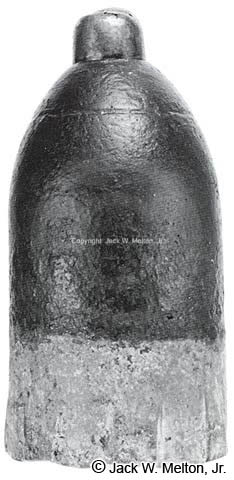Bashley Britten's Projectile
Bashley Britten, of Great Britain, patented a method of attaching the lead sabot to the base of a projectile dated March 17, 1855, British patent #604. He describes this method in detail in his British patent #585, dated March 8, 1861, and states that "I apply a coating of lead formed in such a manner that on the gun being fired, the lead expands into the rifle grooves, and is acted upon by the rifling so as to produce a rotatory motion in the shell. I unite the lead to the iron shell by means of solder, zinc, or tin. At the base of the shell I attach a coating or sabot of lead; This is done by first removing the impurities on the cast surface of the shell either by tools or by subjecting the iron to the action of a strong pickle of sulphuric or other acid. This portion of the shell is then immersed in a bath of melted zinc, tin, or solder, to become coated with such metal. The shell is then taken out, and as quickly as possible placed in a mould of the required form containing melted lead, which on cooling becomes firmly attached to the projectile."
The purpose of his invention was to increase the range and accuracy of rifled projectiles fired from cannon. The propellant charge would force the lead sabot forward, expanding the circumference of the lead around the rounded iron base. During this movement, the lead edge or wall at the circumference would expand into the grooves of the rifled cannon during the explosion of the propellant charge.
As can be seen in the photograph of the 3.5 inch Britten segmented-shell , in-between
the iron base and the lead cup or sabot (1), is a thin layer of tin (2). The tin, when
applied properly, almost always bonded to keep the lead sabot fuzed to the bottom of the
iron base of the projectile.
, in-between
the iron base and the lead cup or sabot (1), is a thin layer of tin (2). The tin, when
applied properly, almost always bonded to keep the lead sabot fuzed to the bottom of the
iron base of the projectile.
The percussion fuzing system shown was also patented by Bashley Britten, British patent #585, dated March 8, 1861. The fuze is made up of three components: a cylindrical case (3) open at one end, and having a somewhat contracted aperture at other, a metallic cap (4) or cover that is screwed onto the case (left-hand threads), and a movable striker (5) which is formed with a nipple so as to retain a percussion cap. According to Britten's patent, in order to hold the striker in place to prevent an accidental discharge of the round, a ring of lead or other material is tightly driven into the space between the outer case and the striker base. Upon ignition of the propellant charge the inertia of the striker pushes the ring into the cavity of the projectile. This action released the striker so that upon impact the striker moves forward crushing the percussion cap, thus setting off the inner bursting charge. This ring of lead may sometimes be left out and the striker remaining free. This ring of lead may sometimes be left out and the striker remaining free. Often the slider would bind or wedge itself slightly at an angle inside the case, preventing forward movement.
The interior was manufactured in the following manner: A core of loam or sand was formed to make the inner bursting charge of the projectile. Around this core numerous pieces are placed in a similar form to the divisions of an orange. Each wedge or section (6) has thin iron dividers (7) that are cast into them so as to weaken them at those places. This allows the 9 long wedges to break into 54 segments and the outer shell body into numerous pieces as well. The surfaces of these wedges are dressed over with a coating of loam or suitable material, and they are bound round with a wire (8). The wire secured the segmented-pieces around the inner core of loam or sand. The surface dressing on the outer segments serves to help prevent the inner shell body from adhering to them during the casting process. The outer shell body is cast around this combined bound core of segments, with a rod or mandrel holding the combined core in place, thus leaving a space for the fuze opening. After cooling, the inner core of loam or sand is removed, leaving a chamber for the bursting charge. After this process the lead sabot was cast on the base in the manner as described by Britten.
Most 3.5-inch caliber Britten projectiles, for the imported 12-pounder English Blakely rifle, were fired by the Confederates and have been recovered from Spanish Fort, Alabama, and Brandy Station, Virginia.